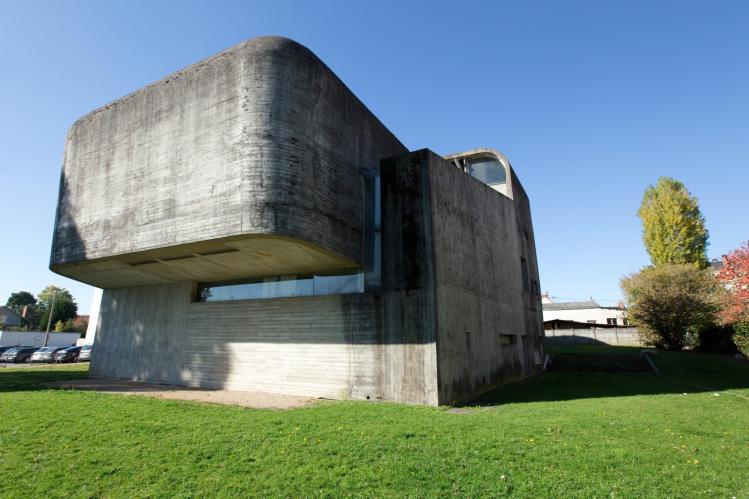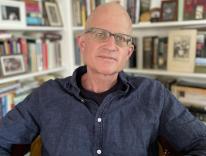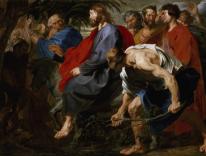
In the early 1960s, Bishop Michel-Louis Vial of Nevers, France, held an open competition to design a church in honor of St. Bernadette Soubirous, famous for her visions of Mary at Lourdes a century earlier. Among the submissions was a plan for a strange, hulking assemblage of gray stone and cement, modeled after bunkers from the Second World War. Designed by a pair of France’s most inventive architectural thinkers, Claude Parent and Paul Virilio, the church features two massive, curved shells that rise to a fracture at their apexes. Shaped like a periscope, the fracture allows natural light to penetrate down into the center of a sanctuary made of sloped planes. The interior is modeled after an anatomical heart, leading congregants to circulate through ventricles to Confession and Communion.
Alienating as it might appear, the church is warmly lit inside, with broad, rounded walls that recall the cave where Mary appeared to Bernadette. Outside, simple grass surrounds the behemoth, suggesting the fortifications flanked by natural landscapes in the north of occupied France, where Virilio, born in 1932, had his childhood punctuated by air raids.
It was a jarring way to honor a saint who saw Mary in a grotto, where millions now travel each year in hopes of healing. Bishop Vial admitted as much to Virilio, as the latter recalled in an interview years later: “‘The other project being considered,’ [the bishop] told me, ‘is a small chapel with little angels, but there is so much hatred for your project, this pile of concrete, that I am going to choose it.’” Construction of the Church of St. Bernadette in Banlay, or more colloquially the “bunker church” or “blockhouse,” finished in 1966.
Two years later, when Paris erupted, Virilio joined students and radicals squatting at the Théâtre de l’Odéon. He was an odd presence among the other soixante-huitards (’68ers), having converted to Catholicism through his association with worker-priests when he was eighteen. (His father was an Italian Communist, his mother a Catholic Breton.) Yet he made a forceful impression, delivering impromptu lectures in the occupied theater on the use of space, leading students to nominate him as a professor at the École Spéciale d’Architecture.
From this improvised academic position, Virilio became one of the most incisive critics of the militarization of society. While the bunker church functioned as a critique of a spectral war characterized by the threat of mutually assured destruction, he would go on to investigate the looming dangers for a weaponized world after the digital revolution.
As one of France’s foremost public intellectuals, Virilio explored themes like the accelerated pace of society, the way weapons technologies creep into civilian life, and our shrinking sphere of privacy. But Virilio’s most ominous warning was about what he called the “information bomb,” which would be for the information sciences what the nuclear bomb was for the physical sciences. All technologies, he argued, contain unforeseen accidents waiting to happen. In an increasingly globalized, computerized, and interconnected society, Virilio explored the consequences of accidents that occur everywhere simultaneously, unmoored from spatial or temporal limitations. He suggested that the 2008 financial crisis, which spread like a virus around the world, was a portent of things to come.
Virilio died last year on September 10, the day before the United States and its allies commemorated an event that expanded the reach of surveillance states, only hastening a world of constant overexposure. We are surrounded by orbiting satellites, a network of devices and data, all with their own catastrophic potential. Virilio knew that there could be no new bunker church, an artifact of an era when we at least knew what we were sheltering from. But he never succumbed to despair, managing to hope against hope, clinging to the possibility that we could still find other grottos in our world, other places where Mary might appear to peasant girls dismissed by local authorities.
Reflecting on the cave in Lourdes, Virilio explained, “Men would also take prostitutes there at night. That’s where the Virgin Mary was about to appear, which perfectly fits my faith, moreover. She appears where danger grows, preceded by the prostitutes and the good thieves. It’s all there.”
Whatever accidents await us, Virilio sensed them coming. It seems unlikely that we are capable of taking the radical steps necessary to stop them. But perhaps we can take comfort imagining Virilio in that great cloud of witnesses, interceding on our behalf, praying that Mary might still appear where danger grows.
Please email comments to [email protected] and join the conversation on our Facebook page.
Previous Story
Blessed, But Also Ordained
Next Story
Remembering Gary Gutting


